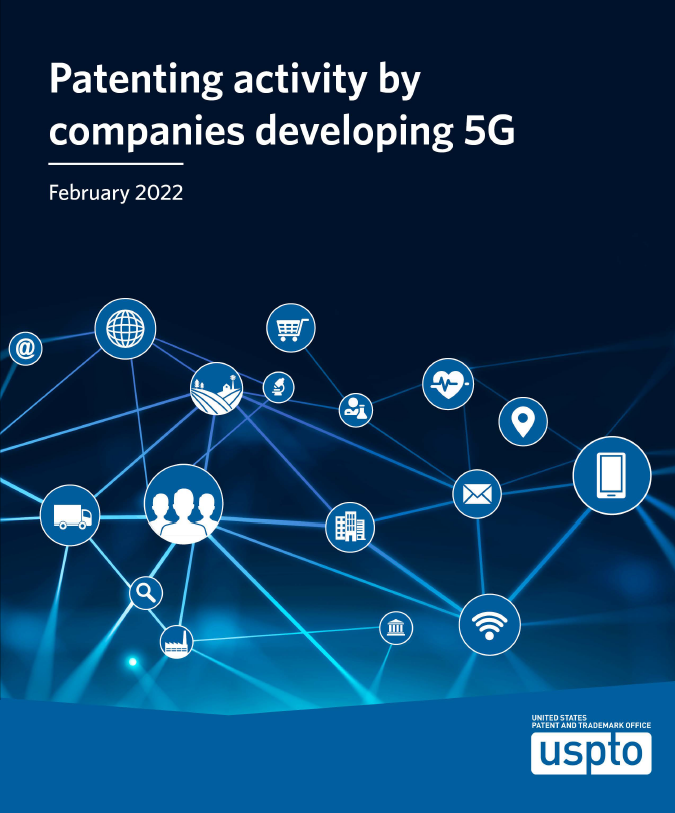Just yesterday, on February 15th, the United States Patent and Trademark Office (USPTO) published a new report called “Patenting Activity among 5G Technology Developers”.
 Unique among studies on 5G patenting activity, this report examines overall patenting trends as well as trends in patent filings and value indicators in the four most-patented 5G-related technologies.
Unique among studies on 5G patenting activity, this report examines overall patenting trends as well as trends in patent filings and value indicators in the four most-patented 5G-related technologies.
“5G and later-generation wireless communications technologies will touch every aspect of the lives of U.S. workers and businesses and help close the digital divide,” said United States Secretary of Commerce Gina Raimondo.
Utilizing IPlytics data from May 2021, the report looked at both global 5G patent families – filed anywhere in the world – and triadic patent families in which a patent or application is filed in each of the USPTO, European Patent Office and Japan Patent Office. Based on the report’s analysis of patenting activity, the six most active 5G companies are Ericsson, Huawei, LG, Nokia, Qualcomm, and Samsung. A more recent 5G patent study published in November 2021 by IPlytics also identifies ZTE in the top 5G patent owner list.
When analyzing self-declared SEPs is quality, not quantity, as not all declared patents are verified essential. The share of fully mappable patents, that is, patents where all claim elements were found in the 5G standard specification and a claim chart was made to justify that the patent is essential, differs strongly across the self-declared 5G patent portfolios and ranges from 5G portfolios with an essentiality rate of only 6% to 5G portfolios with an essentiality rate of 30% (as to the IPlytics 5G report). The ranking of 5G patent owners must consider these essentiality rate differences to make accurate assumptions about the 5G leadership situation. Patent declaration data as used in the USPTO report is however the starting point to identify the strongest 5G patent owners while the 5G shares need further refinement to adjust 5G portfolios by the different essentiality rates.
The USPTO report identified 42,712 ETSI-declared 5G patent families. It is economically not feasible to manually map over forty thousand of patent families. First AI based algorithms bring a redefined approach to this problem allowing to estimate the likelihood of essentiality of declared patents on a much larger scale. Will AI based SEP determination may not replace subject matter expert claim charting it may soon become a first-step approach to determine essentiality for self-declared patent portfolios before spending time and money.
The USPTO report shows that beyond Qualcomm, there are no major 5G SEP players based in the US. Consequently, the US is going to be relying on a lot of 5G hardware and software whose foundational technologies are covered by IP held by non-US entities with an increasing share of Chinese players such as Huawei, ZTE, CATT Datang Mobile, Oppo, Vivo or Xiaomi. All these Chinese companies are so called net licensees – SEP owners that use SEPs mainly for cross-licensing typically not actively enforcing SEPs. A ban from the US market may however change that situation, where a company such as Huawei find itself not selling products in the US while owning a huge 5G SEP portfolio granted and valid in the US. Huawei may want to enforce and commercialize its US SEP portfolio to recoup their investments and without products in the US market, they may act as an NPE which ultimately will increase royalties for US companies implementing 5G technology. The IPlytics data shows the dynamics of the past 10 years where the 5G patent ownership share of Chinese patent holders massively increased, while the US companies’ share has been constantly decreasing with regards to 4G/5G patent ownership.

![[IPWatchdog Logo]](https://ipwatchdog.com/wp-content/themes/IPWatchdog%20-%202023/assets/images/temp/logo-small@2x.png)


![[Advertisement]](https://ipwatchdog.com/wp-content/uploads/2024/04/Patent-Litigation-Masters-2024-sidebar-early-bird-ends-Apr-21-last-chance-700x500-1.jpg)

![[Advertisement]](https://ipwatchdog.com/wp-content/uploads/2021/12/WEBINAR-336-x-280-px.png)
![[Advertisement]](https://ipwatchdog.com/wp-content/uploads/2021/12/2021-Patent-Practice-on-Demand-recorded-Feb-2021-336-x-280.jpg)
![[Advertisement]](https://ipwatchdog.com/wp-content/uploads/2021/12/Ad-4-The-Invent-Patent-System™.png)

Join the Discussion
No comments yet.